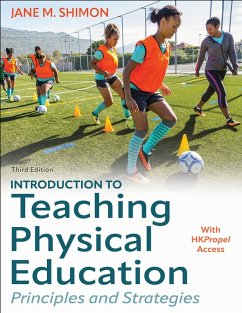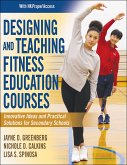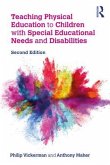- Broschiertes Buch
- Merkliste
- Auf die Merkliste
- Bewerten Bewerten
- Teilen
- Produkt teilen
- Produkterinnerung
- Produkterinnerung
Develop teaching skills through a blend of theory and practice for future physical educators. Revised to meet national standards, the content stresses social-emotional learning, inclusive instruction, and tech integration. Practical sidebars, case studies, and prompts guide learners in mastering essential strategies.
Andere Kunden interessierten sich auch für
![Health and Physical Education for Elementary Classroom Teachers Health and Physical Education for Elementary Classroom Teachers]() Retta R. EvansHealth and Physical Education for Elementary Classroom Teachers101,99 €
Retta R. EvansHealth and Physical Education for Elementary Classroom Teachers101,99 €![Functional Strength Training for Physical Education Functional Strength Training for Physical Education]() Nate VanKouwenbergFunctional Strength Training for Physical Education57,99 €
Nate VanKouwenbergFunctional Strength Training for Physical Education57,99 €![Designing and Teaching Fitness Education Courses Designing and Teaching Fitness Education Courses]() Jayne D. GreenbergDesigning and Teaching Fitness Education Courses67,99 €
Jayne D. GreenbergDesigning and Teaching Fitness Education Courses67,99 €![Physical Drill With and Without Arms and the New Bayonet Exercise [electronic Resource] Physical Drill With and Without Arms and the New Bayonet Exercise [electronic Resource]]() Physical Drill With and Without Arms and the New Bayonet Exercise [electronic Resource]20,99 €
Physical Drill With and Without Arms and the New Bayonet Exercise [electronic Resource]20,99 €![Hand-book of Calisthenics and Gymnastics: a Complete Drill-book for School, Families, and Gymnasius With Music to Accompany the Exercises Hand-book of Calisthenics and Gymnastics: a Complete Drill-book for School, Families, and Gymnasius With Music to Accompany the Exercises]() Hand-book of Calisthenics and Gymnastics: a Complete Drill-book for School, Families, and Gymnasius With Music to Accompany the Exercises30,99 €
Hand-book of Calisthenics and Gymnastics: a Complete Drill-book for School, Families, and Gymnasius With Music to Accompany the Exercises30,99 €![Teaching Physical Education to Children with Special Educational Needs and Disabilities Teaching Physical Education to Children with Special Educational Needs and Disabilities]() Philip Vickerman (UK Liverpool John Moores University)Teaching Physical Education to Children with Special Educational Needs and Disabilities40,99 €
Philip Vickerman (UK Liverpool John Moores University)Teaching Physical Education to Children with Special Educational Needs and Disabilities40,99 €![Health Exercises and Home Gymnastics: How to Train, Strengthen, and Develop the Body Without Use of Dumb-bells or Other Appliances, With Some Exercise Health Exercises and Home Gymnastics: How to Train, Strengthen, and Develop the Body Without Use of Dumb-bells or Other Appliances, With Some Exercise]() Hartvig 1856-1924 NissenHealth Exercises and Home Gymnastics: How to Train, Strengthen, and Develop the Body Without Use of Dumb-bells or Other Appliances, With Some Exercise17,99 €
Hartvig 1856-1924 NissenHealth Exercises and Home Gymnastics: How to Train, Strengthen, and Develop the Body Without Use of Dumb-bells or Other Appliances, With Some Exercise17,99 €-
-
-
Develop teaching skills through a blend of theory and practice for future physical educators. Revised to meet national standards, the content stresses social-emotional learning, inclusive instruction, and tech integration. Practical sidebars, case studies, and prompts guide learners in mastering essential strategies.
Produktdetails
- Produktdetails
- Verlag: Human Kinetics Publishers
- Third Edition
- Seitenzahl: 256
- Erscheinungstermin: 30. April 2025
- Englisch
- Abmessung: 217mm x 286mm x 20mm
- Gewicht: 744g
- ISBN-13: 9781718217348
- ISBN-10: 171821734X
- Artikelnr.: 72502847
- Herstellerkennzeichnung
- Libri GmbH
- Europaallee 1
- 36244 Bad Hersfeld
- gpsr@libri.de
- Verlag: Human Kinetics Publishers
- Third Edition
- Seitenzahl: 256
- Erscheinungstermin: 30. April 2025
- Englisch
- Abmessung: 217mm x 286mm x 20mm
- Gewicht: 744g
- ISBN-13: 9781718217348
- ISBN-10: 171821734X
- Artikelnr.: 72502847
- Herstellerkennzeichnung
- Libri GmbH
- Europaallee 1
- 36244 Bad Hersfeld
- gpsr@libri.de
Jane M. Shimon, EdD, AT-Ret., is a professor and the codirector of the K-12 physical education and health program at Boise State University in Boise, Idaho. She was named Outstanding College Educator of the Year by Idaho AHPERD in 2006, was the University Educator of the Year for AAHPERD’s Northwest District in 2007, and was the Idaho AHPERD Distinguished Service recipient in 2012. Shimon has firsthand experience in teaching physical education and health at the secondary level and has been teaching Introduction to Physical Education since 2000. She has supervised student teachers in rural, urban, and suburban areas in many states across the country. These experiences have broadened her views of physical education programs and teaching practices. Shimon has been a member of various SHAPE America state organizations and has served on the editorial board of Journal of Physical Education, Recreation and Dance and on a subcommittee for the National Association for Sport and Physical Education.
Part I. Behind the Scenes of Physical Education
Chapter 1. History of Physical Education
The Beginning
Physical Education in the United States
Early American Period: Mid-1700s to 1900
Early 20th Century: 1900 to 1930
Mid-20th Century: 1930 to 1970
Late 20th Century: 1970 to 2000
Early 21st Century: 2000 to Present
Summary
Chapter 2. Purpose, Benefits, and Philosophy
Purpose of Physical Education
National Physical Education Standards
Benefits of Physical Education
Philosophy of Physical Education
Summary
Chapter 3. Duties and Challenges
Teaching Duties and Roles
Nonteaching Duties
Issues and Concerns
Summary
Part II. Teaching Physical Education
Chapter 4. Organization and Instruction
Noninstructional Tasks: Classroom Organization
Instructional Tasks
Content Progressions and Practice Strategies
Teaching Styles
Summary
Chapter 5. Motivation
Motivational Theories
Strategies to Enhance Motivation
Summary
Chapter 6. Behavior Management
Behavior Management Safeguards
Behavior Management Strategies
Summary
Part III. Lesson Planning and Outcomes
Chapter 7. Scope and Sequence
Scope: Pre-Kindergarten (Pre-K)
Scope: Elementary School
Scope: Middle School and Junior High School
Scope: High School
Sequence
Summary
Chapter 8. Lesson Planning
Writing Learning Outcomes (Objectives) for a Lesson Plan
Creating Lesson Plans
Supporting Individual Differences
Supporting Social and Emotional Learning
Summary
Chapter 9. Student Assessment
Terminology
Assessment Options
Types of Rubrics
Rubric Construction
Grading Considerations
Health-Related Fitness Testing
Constructing Written Tests
Summary
Part IV. Beyond the Classroom
Chapter 10. Technology and Resources
Instructional Technology
Online Resources
Summary
Chapter 11. Careers in Physical Education
Alternative School Settings
Other Career Avenues
Summary
Appendix A. Appropriate Practice Guidelines and Instructional
Strategies-SHAPE America 2009
Appendix B. Example of Class Policies and Expectations
Chapter 1. History of Physical Education
The Beginning
Physical Education in the United States
Early American Period: Mid-1700s to 1900
Early 20th Century: 1900 to 1930
Mid-20th Century: 1930 to 1970
Late 20th Century: 1970 to 2000
Early 21st Century: 2000 to Present
Summary
Chapter 2. Purpose, Benefits, and Philosophy
Purpose of Physical Education
National Physical Education Standards
Benefits of Physical Education
Philosophy of Physical Education
Summary
Chapter 3. Duties and Challenges
Teaching Duties and Roles
Nonteaching Duties
Issues and Concerns
Summary
Part II. Teaching Physical Education
Chapter 4. Organization and Instruction
Noninstructional Tasks: Classroom Organization
Instructional Tasks
Content Progressions and Practice Strategies
Teaching Styles
Summary
Chapter 5. Motivation
Motivational Theories
Strategies to Enhance Motivation
Summary
Chapter 6. Behavior Management
Behavior Management Safeguards
Behavior Management Strategies
Summary
Part III. Lesson Planning and Outcomes
Chapter 7. Scope and Sequence
Scope: Pre-Kindergarten (Pre-K)
Scope: Elementary School
Scope: Middle School and Junior High School
Scope: High School
Sequence
Summary
Chapter 8. Lesson Planning
Writing Learning Outcomes (Objectives) for a Lesson Plan
Creating Lesson Plans
Supporting Individual Differences
Supporting Social and Emotional Learning
Summary
Chapter 9. Student Assessment
Terminology
Assessment Options
Types of Rubrics
Rubric Construction
Grading Considerations
Health-Related Fitness Testing
Constructing Written Tests
Summary
Part IV. Beyond the Classroom
Chapter 10. Technology and Resources
Instructional Technology
Online Resources
Summary
Chapter 11. Careers in Physical Education
Alternative School Settings
Other Career Avenues
Summary
Appendix A. Appropriate Practice Guidelines and Instructional
Strategies-SHAPE America 2009
Appendix B. Example of Class Policies and Expectations
Part I. Behind the Scenes of Physical Education
Chapter 1. History of Physical Education
The Beginning
Physical Education in the United States
Early American Period: Mid-1700s to 1900
Early 20th Century: 1900 to 1930
Mid-20th Century: 1930 to 1970
Late 20th Century: 1970 to 2000
Early 21st Century: 2000 to Present
Summary
Chapter 2. Purpose, Benefits, and Philosophy
Purpose of Physical Education
National Physical Education Standards
Benefits of Physical Education
Philosophy of Physical Education
Summary
Chapter 3. Duties and Challenges
Teaching Duties and Roles
Nonteaching Duties
Issues and Concerns
Summary
Part II. Teaching Physical Education
Chapter 4. Organization and Instruction
Noninstructional Tasks: Classroom Organization
Instructional Tasks
Content Progressions and Practice Strategies
Teaching Styles
Summary
Chapter 5. Motivation
Motivational Theories
Strategies to Enhance Motivation
Summary
Chapter 6. Behavior Management
Behavior Management Safeguards
Behavior Management Strategies
Summary
Part III. Lesson Planning and Outcomes
Chapter 7. Scope and Sequence
Scope: Pre-Kindergarten (Pre-K)
Scope: Elementary School
Scope: Middle School and Junior High School
Scope: High School
Sequence
Summary
Chapter 8. Lesson Planning
Writing Learning Outcomes (Objectives) for a Lesson Plan
Creating Lesson Plans
Supporting Individual Differences
Supporting Social and Emotional Learning
Summary
Chapter 9. Student Assessment
Terminology
Assessment Options
Types of Rubrics
Rubric Construction
Grading Considerations
Health-Related Fitness Testing
Constructing Written Tests
Summary
Part IV. Beyond the Classroom
Chapter 10. Technology and Resources
Instructional Technology
Online Resources
Summary
Chapter 11. Careers in Physical Education
Alternative School Settings
Other Career Avenues
Summary
Appendix A. Appropriate Practice Guidelines and Instructional
Strategies-SHAPE America 2009
Appendix B. Example of Class Policies and Expectations
Chapter 1. History of Physical Education
The Beginning
Physical Education in the United States
Early American Period: Mid-1700s to 1900
Early 20th Century: 1900 to 1930
Mid-20th Century: 1930 to 1970
Late 20th Century: 1970 to 2000
Early 21st Century: 2000 to Present
Summary
Chapter 2. Purpose, Benefits, and Philosophy
Purpose of Physical Education
National Physical Education Standards
Benefits of Physical Education
Philosophy of Physical Education
Summary
Chapter 3. Duties and Challenges
Teaching Duties and Roles
Nonteaching Duties
Issues and Concerns
Summary
Part II. Teaching Physical Education
Chapter 4. Organization and Instruction
Noninstructional Tasks: Classroom Organization
Instructional Tasks
Content Progressions and Practice Strategies
Teaching Styles
Summary
Chapter 5. Motivation
Motivational Theories
Strategies to Enhance Motivation
Summary
Chapter 6. Behavior Management
Behavior Management Safeguards
Behavior Management Strategies
Summary
Part III. Lesson Planning and Outcomes
Chapter 7. Scope and Sequence
Scope: Pre-Kindergarten (Pre-K)
Scope: Elementary School
Scope: Middle School and Junior High School
Scope: High School
Sequence
Summary
Chapter 8. Lesson Planning
Writing Learning Outcomes (Objectives) for a Lesson Plan
Creating Lesson Plans
Supporting Individual Differences
Supporting Social and Emotional Learning
Summary
Chapter 9. Student Assessment
Terminology
Assessment Options
Types of Rubrics
Rubric Construction
Grading Considerations
Health-Related Fitness Testing
Constructing Written Tests
Summary
Part IV. Beyond the Classroom
Chapter 10. Technology and Resources
Instructional Technology
Online Resources
Summary
Chapter 11. Careers in Physical Education
Alternative School Settings
Other Career Avenues
Summary
Appendix A. Appropriate Practice Guidelines and Instructional
Strategies-SHAPE America 2009
Appendix B. Example of Class Policies and Expectations





![Physical Drill With and Without Arms and the New Bayonet Exercise [electronic Resource] Physical Drill With and Without Arms and the New Bayonet Exercise [electronic Resource]](https://bilder.buecher.de/produkte/65/65492/65492706m.jpg)


